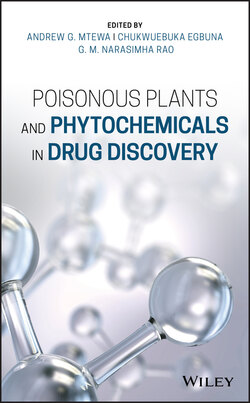Читать книгу Poisonous Plants and Phytochemicals in Drug Discovery - Группа авторов - Страница 54
References
Оглавление1 1 Berestetskiy, A.O. (2008). A review of fungal phytotoxins: from basic studies to practical use. Applied Biochemistry and Microbiology 44 (5): 453.
2 2 Turkkan, M. and Dolar, F.S. (2008). Role of phytotoxins in plant diseases. Tarim Bilimleri Dergis 14 (1): 87–94.
3 3 Stierle, A.A. and Stierle, D.B. (2015). Bioactive secondary metabolites produced by the fungal endophytes of conifers. Natural Product Communications 10 (10): 1671–1682.
4 4 Yoder, O.C. (1980). Toxins in pathogenesis. Annual Review of Phytopathology 18 (1): 103–129.
5 5 Tsuge, T., Harimoto, Y., Akimitsu, K. et al. (2013). Host‐selective toxins produced by the plant pathogenic fungus Alternaria alternata. FEMS Microbiology Reviews 37 (1): 44–66.
6 6 Howlett, B.J. (2006). Secondary metabolite toxins and nutrition of plant pathogenic fungi. Current Opinion in Plant Biology 9 (4): 371–375.
7 7 Wolpert, T.J., Dunkle, L.D., and Ciuffetti, L.M. (2002). Host‐selective toxins and avirulence determinants: what's in a name? Annual Review of Phytopathology 40 (1): 251–285.
8 8 Stergiopoulos, I., Collemare, J., Mehrabi, R., and De Wit, P.J.G.M. (2013). Phytotoxic secondary metabolites and peptides produced by plant pathogenic Dothideomycete fungi. FEMS Microbiology Reviews 37 (1): 67–93.
9 9 Rai, M., Rathod, D., Agarkar, G. et al. (2014). Fungal growth promotor endophytes: a pragmatic approach towards sustainable food and agriculture. Symbiosis 62 (2): 63–79.
10 10 Shurigin, V., Davranov, K., Wirth, S. et al. (2018). Medicinal plants with phytotoxic activity harbour endophytic bacteria with plant growth inhibitory properties. Environmental Sustainability 1 (2): 209–215.
11 11 Kodama, M., Akagi, Y., Takao, K., and Tsuge, T. (2015). Mycotoxins vs. phytotoxins: are they the same, or just similar? JSM Mycotoxins 65 (1): 57–62.
12 12 Friesen, T.L., Faris, J.D., Solomon, P.S., and Oliver, R.P. (2008). Host‐specific toxins: effectors of necrotrophic pathogenicity. Cellular Microbiology 10 (7): 1421–1428.
13 13 WHO (2019). Natural Toxins in Food. Geneva, Switzerland: World Health Organization.
14 14 Burrows, G.E. and Tyrl, R.J. (2012). Toxic Plants of North America. Wiley.
15 15 Quattrocchi, U. (2016). CRC World Dictionary of Medicinal and Poisonous Plants: Common Names, Scientific Names, Eponyms, Synonyms, and Etymology (5 Volume Set). CRC Press.
16 16 Judson, R., Richard, A., Dix, D. et al. (2008). ACToR – aggregated computational toxicology resource. Toxicology and Applied Pharmacology 233 (1): 7–13.
17 17 Kupper, J., Waidyasekera, D., Schonenberger, W. et al. (2004). CliniTox: the computer‐based information system for poisoning in farm animals. DTW. Deutsche Tierarztliche Wochenschrift 111 (11): 433–438.
18 18 CliniTox. 2004). www.vetpharm.uzh.ch/perldocs/toxsyqry.htm (accessed 14 October 2019).
19 19 Günthardt, B.F., Hollender, J., Hungerbühler, K. et al. (2018). Comprehensive toxic plants – phytotoxins database and its application in assessing aquatic micropollution potential. Journal of Agricultural and Food Chemistry 66 (29): 7577–7588.
20 20 Schmidt, U., Struck, S., Gruening, B. et al. (2009). SuperToxic: a comprehensive database of toxic compounds. Nucleic Acids Research 37(Database issue): D295–D299.
21 21 European Food Safety Authority (2012). Compendium of botanicals reported to contain naturally occurring substances of possible concern for human health when used in food and food supplements. EFSA Journal 10 (5): 2663.
22 22 Banerjee, P., Erehman, J., Gohlke, B.O. et al. (2015). Super natural II – a database of natural products. Nucleic Acids Research 43(Database issue): D935–D939.
23 23 Nakamura, K., Shimura, N., Otabe, Y. et al. (2013). KNApSAcK‐3D: a three‐dimensional structure database of plant metabolites. Plant and Cell Physiology 54 (2): e4–e4.
24 24 Afendi, F.M., Okada, T., Yamazaki, M. et al. (2011). KNApSAcK family databases: integrated metabolite–plant species databases for multifaceted plant research. Plant and Cell Physiology 53 (2): e1–e1.
25 25 Takahashi, H., Hirai, A., Shojo, M. et al. (2011). Species metabolites relation database KNApSAcK and its multifaceted retrieval system, KNApSAcK family in general. In: Handbook of Applied Systems Toxicology (eds. D.A. Casciano and S.C. Sahu). 291‐298. Chichester, UK: Wiley.
26 26 Najberek, K., Pusz, W., Solarz, W., and Olejniczak, P. (2018). The seeds of success: release from fungal attack on seeds may influence the invasiveness of alien impatiens. Plant Ecology 219 (10): 1197–1207.
27 27 Oku, H. and Nakanishi, T. (1963). A toxic metabolite from Ascochyta fabae having antibiotic activity. Phytopathology 53 (10): 1321–1325.
28 28 Berestetskiĭ, O.A. and Borovkov, A.V. (1979). Phytotoxic metabolites of soil penicillia. Mikrobiologicheskiĭ Zhurnal 41: 291–302.
29 29 Duke, S.O., Dayan, F.E., Rimando, A.M. et al. (2002). Chemicals from nature for weed management. Weed Science 50 (2): 138–151.
